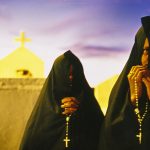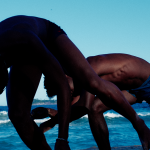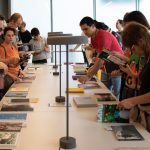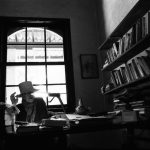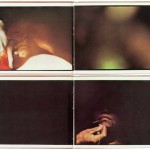Sebastião Salgado, a Man of Contradictions
Publicado em: 26 de May de 2015
With Genesis, his most ambitious project so far, dedicated to portraying regions of the planet that foster nature at its untouched form or groups of humans that are isolated from civilization, Sebastião Salgado has attained unprecedented visibility for a Brazilian photographer. His entrepreneurial sense has transformed ten years of work into books, exhibitions and a documentary which he co-directed with filmmaker Wim Wenders. The photographer’s much publicized fame has given rise to contrasting readings. For some, he has a romantic vision of the world; for others, he is an exploiter who aestheticizes suffering. In this article, critics and specialists comment on the oeuvre of the Paris-based photographer, who was born in the state of Minas Gerais, Brazil. |
When he was working on Genesis (2013), his most recent project, photographer Sebastião Salgado claimed to have followed Charles Darwin’s steps, having read the author’s The Voyage of the Beagle (1839). On his first day at work, Salgado visited one of the Galapagos Islands in the Pacific, at the foot of the Alcedo volcano, and found a tortoise of the species that lends its name to the Equatorial archipelago. He reports having trouble photographing the giant reptile, until he had the idea of crouching down and moving about on all fours. By remaining at the animal’s height, Salgado believes he sent a message of respect, the same attitude that he consciously adopted so many other times when he portrayed a man, a woman or a child.
“When I photograph human beings, I never approach a group furtively or by surprise, I always introduce myself. Then I speak to the people, explain what I’m doing, talk to them, and slowly we get to know each other. I realized that, in the same way, I would only be able to photograph that tortoise if I got to know it; I needed to adapt myself to it. So I turned myself into a tortoise,” reports Salgado in his autobiography, From My Land to the Planet (2014). In the same way as Darwin, of whom he claims to be a disciple, Salgado defends the theory that there is a common origin to all living beings. For him, nature and animals are all rational, have a personality, an identity or – a word he frequently uses – a dignity.
Genesis marked a change in Salgado’s successful career. For the first time, the Brazilian photographer documented images of animals and natural landscapes. He associates this decision with the deep hopelessness which took hold of him when covering the genocide in Rwanda in 1994, during which at least 800,000 people were killed. In the documentary The Salt of the Earth (2014), co-directed by his son Juliano Ribeiro Salgado and the German filmmaker Wim Wenders, Salgado once again revealed his pessimism as regards the human species. Some of his photographs portraying the effect of the genocide are included in his book Exodus (2000). In the making of this six-year project about refugees, Salgado shows his discouragement: “I had faced our species at its worst and most violent and ceased to believe that it could ever be saved. With Genesis, I changed my mind.”
“He is very passionate about his work,” says Edward Burtynsky, an award-winning Canadian photographer whose work depicts the changes that industry makes to natural landscapes. “Genesis deals with hope when it points to the need to preserve an intact ecological system. There is something to fight for,” he continues. As a professional, Burtynsky admits having the same concerns as Salgado, albeit his approach is “diametrically opposite” to his. With his hyperrealist colour photographs, frequently taken from an aerial perspective, Burtynski does not convey an attitude of veneration or respect as regards nature. “What I do is expand our consciousness about the consequences of mining, of water use or of deforestation on our daily urban life,” he says. “My work is an alert to the unprecedented scale and speed of the growth of industrial production, aimed at meeting our growing consumption demands. At this rate, entire species will be in danger of extinction.”
Despite having started Genesis using a analog camera, Salgado changed his mind and started using a digital one during the course of the endeavour. There are no other novelties, though. The use of black and white, the composition, the tonality, the baroque aesthetic and the dramatic effects that Salgado employed in his previous works are all used in Genesis, an attempt to show us places in the planet that remain untouched by urbanization. “Indeed, he retained his own technique and singular aesthetic, but the focus of his attention is different in the new project,” says David Levi Strauss, art critic and Chair of the Art Criticism and Writing course at the School of Visual Arts in New York. Author of The Cruel Radiance: Photography and Political Violence (2010), journalist Susie Linfield believes that Salgado’s approach is frequently reverential to that which he chooses to photograph. “His images, in a pleasant black and white, are painstakingly composed, are dramatically theatrical and make use of light in a similar way to painting,” writes Linfield. “It is true that Salgado’s photographs may suggest a kind of nostalgic romanticism reminiscent of Socialist Realism.” Officially adopted by the former Soviet Union, Socialist Realism is a doctrine that prescribes that the arts must participate in the consolidation of the Communist regime with a supposedly realist vision of the government’s achievements and devoid of the experimental trends of modern art, which were regarded as bourgeois.
According to Linfield, Salgado is a romantic. He does not have the rebellious nature of French photographer Gilles Peress, for example, as he does not stimulate the spectator to question his way of seeing and what he knows. For Linfield, Peress is a sceptic, someone who bares his own perplexity and mental confusion in his work. Peress doubts himself and assumes that the human condition is destined to failure. “Even after the trauma in Rwanda, which Peres declared was also a turning point in his life, I do not view Salgado as a pessimist. If he ventured out again, to create Genesis, it is because there is a degree of optimism that guides him. He still attempts to communicate with other human beings. He would have stopped if he had completely lost hope,” says Linfield.
The Brazilian photographer rarely discusses the relation between his aesthetic choices and his existential anguishes. In The Salt of the Earth, as noted by Jay Weissberg, an American film critic who writes for Variety magazine, Salgado talked superficially about his profession and spoke very little of his artistic influences. When he speaks in the documentary, nominated for the 2015 Oscars, he mentions Dante Alighieri, Lewis Carroll and Darwin, comparing what he captured in his photographs to the descriptions of the reality depicted in books by the three authors. An advocate of Salgado’s work, defending him against those who have refuted the Brazilian as an exploiter of the suffering of the dispossessed, Strauss claims there is an anti-intellectual bias amidst certain photographers. Some professionals are suspicious of what Strauss classifies as “self-examination”: they ignore the most urgent issues in photographic practice. “Although I do not consider Salgado an anti-intellectual, I have noticed that he avoids talking about the dilemmas of photography,” says Strauss.
Ever since he started his ascent to stardom in the world of photography in the 1980s, Salgado has been repeatedly criticized for being an aesthete, someone concerned primarily with elements of harmony and beauty in photography. Twenty years ago, North American postmodernist critics, among them Susan Sontag, Allan Sekula and Abigail Solomon-Godeau, interpreted Salgado’s hope that his portraits could give a voice and dignity to refugee children, famished people, landless workers and impoverished indigenous populations as “the aestheticization of suffering.” In one of the most ferocious attacks, published in 1991 by The New Yorker magazine and entitled “Good intentions”, Ingrid Sischy said that Salgado had become obsessed with the composition of his photographs: above all, he was interested in finding the “grace” and the “beauty” in the “distorted forms of those he portrayed in agony and distress.”
Sischy prefers the viewpoint of Walker Evans (1903-75), renowned for his work on the Great Depression, undertaken for the Farm Security Administration (a North American governmental agency), and author of portraits of poor sharecroppers in Alabama, collected in Let Us Now Praise Famous Men (1941), with text by James Agee. Unlike Salgado, Evans was neither didactic nor sentimental in photographing the disadvantaged, which in the work of the Brazilian were “carefully composed in the likeness of still lifes.” “And the embellishment of tragedy results in images that ultimately reinforce our passiveness in regards to the experience that they reveal,” writes Sischy. “The aestheticization of tragedy is the fastest way to anesthetise the feelings of those who witness it. Beauty is a call for contemplation, not for action.” Sischy complained of the cult of Salgado, a photojournalist whose work had been accredited with a transformative power over issues relating to class, race and ethnicity.
At the time, Sischy reiterated the theoretical notions of the postmodernists. “By the end of the 1980s, support for documentary practices was regarded, at best, as naïve and, at its worst, as ideologically suspicious,” notes Strauss, author of two essays on Salgado’s photography, compiled in Between the Eyes (2003). “This line of thought has now become the most accepted of the two amongst academics.” According to Strauss, the origin of this idea alludes to Walter Benjamin (1892-1940). In the 1930s, Benjamin reflected on the artistic reaction to expressionism, which became known as New Objectivity. The German philosopher complained about “the way in which certain fashion photographers attempted to transform human misery into a consumer product.” For Benjamin, New Objectivity “transforms political struggle so that it ceases to be a compelling motive for decision and becomes an object of comfortable contemplation.” Strauss refutes the postmodernists’ attempts to transform Salgado into an heir to New Objectivity.
When he reflects on Salgado’s documentary photography, Strauss prefers to quote the Uruguayan writer and journalist Eduardo Galeano, author of one of the texts from An Uncertain Grace (1990), the catalogue of the exhibition organized by journalist Fred Ritchin at the Museum of Modern Art of San Francisco, in 1990. “Salgado photographs people. Casual photographers photograph ghosts,” writes Galeano. “As a consumer product, poverty is a source of morbid pleasure and a fair amount of money. Poverty is a commodity that attains high prices in the market of luxury goods. Photographers from the consumer society get close, but do not penetrate. In hasty visits to scenes of despair and violence, they get off the plane or the helicopter and immediately start shooting, they flash, they document and then they run. They look without seeing, and their images say nothing. Their coward photographs stained with horror and blood may extract a few crocodile tears, some pennies, one or two hypocritical words from the world’s privileged few, and none of that changes the order of the universe.” Strauss defends the theory that the images serve, above all, to document the distance between photographer and the subject. In Salgado’s relationship with the people he portrays, there is no exploitation. Both the North American critic and the Uruguayan author believe that the Brazilian photographer has developed a style that is marked by solidarity – which helps – and not by charity – which humiliates.
In the case of Genesis, what sets Salgado apart from other photojournalists is his attitude, according to Fred Ritchin. “In this project, Salgado behaved like a proactive photographer. The convention of the photojournalistic tradition is that of the reactive photographer. He challenges it. Instead of denouncing a destroyed world, Salgado presents a universe that deserves to be preserved,” says Ritchin, director of the International Centre of Photography (ICP), in Manhattan. The ICP was the only museum to show Genesis in the United States. Salgado’s association with the institution goes back a long way. Founded by Cornell Capa, Robert Capa’s brother and creator of the term “engaged photography,” the ICP previously put on shows of some of the content of Exodus and Workers (1993). Ritchin, who has worked as an editor and curator of Salgado’s work, defines him as a “sentimental, nostalgic, heroic, lyric” photojournalist. In From My Land to the Planet, Salgado described himself in the following way: “I have always been able to position my images within a historical and sociological vision.” If photography is “a type of writing,” Salgado believes he is using it to accomplish something that is common to all photographers: “My photographs are a reference to myself, to that which is going through my mind, that which I am living and thinking.”
The indigenous people from different regions of the planet are part of this world that deserves to be preserved and is defined by Salgado as “pristine”. “The primitive communities,” in the photographer’s definition, are joined by animals in the 31 exhibitions of Genesis, which have been programmed to take place between 2013 and 2016 in Brazil, the United States, Canada, England, Italy, France, Spain, China, Sweden, Germany, South Korea, Switzerland, Singapore and Portugal. “Despite the potential for polemic, placing images of animals and indigenous people next to each other makes sense,” says Strauss. “This portion of humanity represents a real and effective traditional voice in the fight against global warming.” In his autobiography, Salgado justifies the choice: “Mankind was originally very strong and very rich in something we eventually lost with time, as we became urban: our instincts. Instincts allow us to feel and foresee a number of things, a change in temperature or climatic phenomena, through observing the behaviour of animals. In reality, we are abandoning our planet, because the city is another planet.”
When writing A Different Light: the Photography of Sebastião Salgado (2012), Parvati Nair talked to the Brazilian photographer and his wife, Lélia Wanick Salgado. Nair started investigating Salgado’s “planetary photography” because she admired his images with “a very clear narrative about the social and economic problems of the world,” especially in Exodus (1997). She had access to the Genesis material before the final selection was made for the exhibitions – seen by at least 1.5 million visitors – and in books published originally by Taschen in six languages. The German publisher produced the book in several formats, such as the art and the collector’s edition in the United States. The first is composed of five limited editions of 100 copies each, numbered and signed by Salgado. Each copy costs ten thousand dollars and comes with a printed photo and a bookstand designed by the Japanese architect Tadao Ando, weighing a total of 59 kilos. Also numbered and signed, the collector’s edition costs four thousand dollars. The commercial edition in Portuguese costs R$ 199,20, and at least sixty thousand copies were sold in Brazil.
Nair finds continuity between Genesis and Salgado’s previous works. “On one hand, the more recent work provides a closure to a great career dedicated to understanding how modern life has dissociated human beings from nature. On the other, I detect choices that are worthy of criticism from the aesthetical and curatorial perspectives,” she observes. The author of A Different Light repeats Fred Ritchin’s caveat, to whom Lélia’s curatorial approach to Genesis, assembling a great number of images into a single space, can provoke considerable and unwanted interference. “Because of this, the engagement with the content of the photographs is affected,” says Nair, who visited the exhibition at the Museum of Natural History in London, in 2013.
Despite considering herself a “militant advocate of the beauty, the rhetoric and the baroque character of his photography,” Nair believes that the majestic quality present in previous works has disappeared in Genesis. “For the first time, Salgado made use of digital technology and a zoom lens. The digital images have an unnatural contrast and a grey scale that is less evident, and possibly this is why the beauty disappears. Genesis needs another approach and it would be more interesting if it showed the presence of the modern world.” Besides a digital camera, Salgado made use of satellite telephones, military vehicles, vessels, planes and other technological resources to make 32 trips between 2004 and 2012.
Nair says that the juxtaposition of the indigenous people and animals is provocative. “The message is that they are human beings like us, while they also belong to the animal kingdom. Humanity is not the centre, but a part of the world. We share the planet with the rest.” She also declares her annoyance at the romanticism as regards the animals, as though there is no violence or cruelty amongst them. In relation to his portrayal of the indigenous peoples, Genesis reminded her of one of Salgado’s first books, Other Americas (1986), about different indigenous populations of Latin America. “In that work, the subjects seem slightly muted, two-dimensional,” she declares. “He opted for the idealization of pre-modern communities.” What bothered her the most in Genesis was the resemblance to the photographs from the early years of anthropology in the 19th century, a field originally “created as an European and colonizing intellectual project.” “There is a general feeling that the indigenous are an exotic people from a distant place.”
In both A Different Light and in conversation with ZUM, Nair describes Salgado as a man of contradictions. She considers it crucial to look back to his beginnings as an economist who, in 1973, aged 29 and living in Paris, decided to become a photographer. A leftist militant who joined the Ação Popular [Popular front], Salgado moved from São Paulo to Europe because he feared that he and Lélia could become victims of the Brazilian military dictatorship. “We participated in all the demonstrations and all the actions of resistance to the dictatorship and were, along with our comrades, fiercely determined to defend our ideas. This was, of course, extremely dangerous. Our group decided that the youngest of us, who included Lélia and I, should go abroad to study and continue as activists from there, while the older ones would go into hiding,” he declares in From My Land to the Planet. To this day Salgado thinks of socioeconomic problems from a leftist perspective. “We should admit that the consumer society of which we are part exploits and pauperizes the inhabitants of the planet,” he states in his autobiography.
“But there is something contradictory about a marxist who accepts money from private companies to finance his own photographic production. Genesis draws attention to the problem of global warming, but the exhibition and the book are sponsored by Vale [a Brazilian multinational mining company, the third largest in the world],” states Nair. At the same time, Salgado and Lélia founded the Instituto Terra, an environmental project supported by Vale to reforest the Atlantic Forest in the family’s farm in Aimorés, Minas Gerais, where the photographer was raised. “Salgado uses photography to promote his vision of the world, which is planetary and panoramic. And the result is as follows: the greatest critic of the global predicament profits from his work.”
Nair points to the fact that the advertising work produced by Salgado for companies, such as Silk Cut (cigarettes), Le Creuset (cookware), Volvo (cars) and Illy (coffee), is not widely known. In an article for The Independent in 2005, Paul Arden, director of the 1988 advertising campaign for Silk Cut, revealed that the Advertising Standards Authority (ASA, the independent advertising regulatory body for the UK) censured the photographs of the indigenous people of Papua New Guinea taken by Salgado “on the pretext that they were offensive to ethical minorities.” “I think that the ASA got scared because they didn’t know how to look at and interpret the images,” wrote Arden, a collector of Salgado’s work and owner of the Arden and Anstruther photographic gallery in England.
For the campaign for Illy, started in 2002, Salgado visited eight countries (Brazil, India, Ethiopia, Guatemala, Colombia, China, El Salvador and Costa Rica) to photograph the coffee growers and coffee production. “Instead of presenting itself as promoting Illy’s coffee, the campaign’s website states that it is a joint tribute from Illy and Salgado to the coffee growers,” writes Nair in A Different Light. “Clearly, just like the company, Salgado tries to ally his world vision and ethical commitments to his need for involvement in a commercial project. In doing so, however, he embroils his work in the capitalist context he seeks to criticize.” A selection of these photographs about coffee will be presented at Expo Milano this year and published in book form in several countries. Salgado has not responded to ZUM’s interview requests.
During her involvement with the couple, Nair saw that Lélia is “a businesswoman who knows how to fight battles,” and Salgado, “someone who is extremely well-informed, who always speaks of percentages and statistics.” Before founding Amazonas Images, in Paris, in 1994, Salgado worked for three of the most prestigious photography agencies of the world: Sygma, Gamma and Magnum. It was as a member of the latter, founded by Robert Capa, Henri Cartier-Bresson, David Seymour and George Rodger in the 1940s, and which Salgado sees as competitive, that he documented the gunshot assassination attempt on Ronald Reagan in 1981, when he was President of the United States. The exclusive images, reproduced by several media channels around the world, generated considerable income for Magnum at the time. “I should say that, somehow, this shooting was very interesting for me and for Magnum, which was facing financial problems at the time: all my photographs were sold!,” reports Salgado in From My Land to the Planet.
In the same autobiography, he says how “in response to specific needs that were raised by photographers, a division into different sectors was needed for better managing their archives and commercializing their images. I proposed to Magnum the creation of production units. I am sure that they would have improved profitability and coherence. My idea was not accepted.” Salgado and Lélia’s insistence on the need to restructure the agency began to be viewed by colleagues as an individualist attitude, according to a profile feature article on the photographer published by The New Yorker in 2005. “Salgado told me that Lélia participated in meetings at Magnum. The truth is that she has a crucial role and almost no one knows the extent of her importance,” says Nair. Salgado has stated on several occasions that his work is possible thanks to the entrepreneurial organisation and the affective balance which comes from Lélia.
Another aspect of Salgado’s production, which is not widely known, refers to his influences, which he very seldom speaks of. In conversations with the photographer while writing one of the texts of the catalogue for the Territoires et Vies exhibition, held in Paris in 2005, Joaquim Marçal Ferreira de Andrade became aware that the period Salgado spent in Aimorés may have been crucial to his professional development. That was when he came into contact with Christian iconography and the classical language of the photojournalism as practiced in the first half of the 20th century. “Religious symbolism is very present. Salgado mentions that he used to stand by the entrances to the region’s Catholic churches. He admits having inherited the Baroque culture,” says Andrade. “His use of the photographic language is conscious. Part of it begins in the 1950s, when he read magazines such as O Cruzeiro and Manchete, which reproduced the images of the most renowned photojournalists of the time.” The members of Magnum, whose work became widely known due to such Brazilian weekly publications, all had leftist and anti-fascist ideas. The emphasis rested on a subjective interpretation of reality, to which they’d present lines of reasoning marked by different states of mind, such as anger, hope, humour or sadness. “Despite the fact that Genesis transits between artistic and documental photography, it is important to stress that Salgado’s roots lie in photojournalism,” points out Edward Burtynsky.
In his autobiography, Salgado declares that the natural light and the mountains of Minas Gerais have influenced his ability to see. “In the rainy season, when phenomenal storms begin to form, the sky starts to fill with clouds. I was born with images of rays of light streaming through skies, laden with heavy dark clouds. This light permeates my images. In fact, I lived inside them even before I started to produce them. I also grew up with backlight: when I was a child, because of my fair skin, I was always made to wear a hat or sit under a tree. At that time there was no such thing as sunscreen. And I used to watch my father moving towards me in the sun, backlit,” he recounts in From My Land to the Planet.
Author of História da Fotorreportagem no Brasil [history of photojournalism in Brazil] (2003), Andrade considers Workers to be Salgado’s masterpiece, and considers him to be one of the most important photojournalists in history. “He has conceived a project with which he has travelled around the world, working obstinately, with an untiring re-edition and a publication by degrees, which could possibly change our understanding about the modern meaning of work,” says Andrade. With Exodus, something may have changed, although it still represented a singular proposal: the demeanour of a great enterprise aligned with something original. “Both works can be embraced by a single man. Both have a vision of a complex whole and are more authorial than Genesis,” he adds.
Andrade considers that Salgado’s most recent enterprise evokes the production of North American landscape photographers such as Carleton Watkins (1829-1916) and Ansel Adams (1902-84), and the renowned visual language of National Geographic, first published in 1888. “It is inevitable to think of images of untouched areas of the planet taken by these unequalled professionals,” he says. “As we look closely at Genesis, it seems as though the photography is caught in the straitjacket of the black and white. Salgado roamed throughout the world with a digital camera to produce an oeuvre that demanded colour.” In a way, it is as though Genesis could be compared to a Hollywood film: it has maintained a successful formula, but one that lacks originality. ///
images: © Sebastião Salgado and Taschen
+
Genesis, by Sebastião Salgado, (Taschen, 2013)
Sebastião Salgado (1944), a Brazilian photojournalist from Aimorés in Minas Gerais, is the author of Workers and, more recently, Genesis, as well as other works.
Francisco Quinteiro Pires (1982) is a journalist. Born in Brazil, he has been living in New York since 2010.
Article published in ZUM Magazine #8 (april 2015). In this issue it was also published “… And God created Sebastião Salgado”, text by Rodrigo Naves, writer and art critic.
///
Get to know ZUM’s issues | See other highlights from ZUM #8 | Buy this issue





